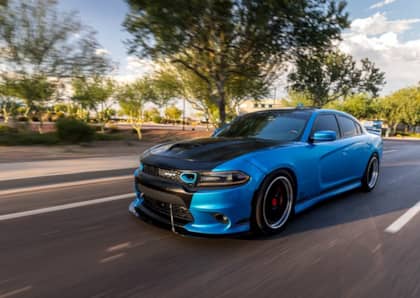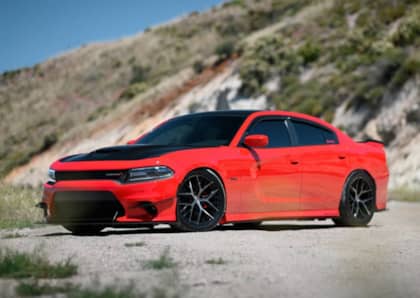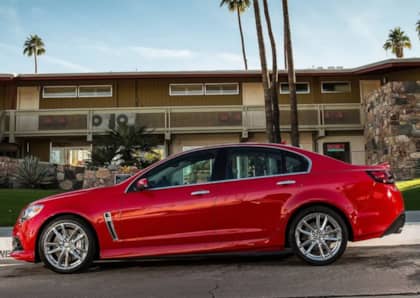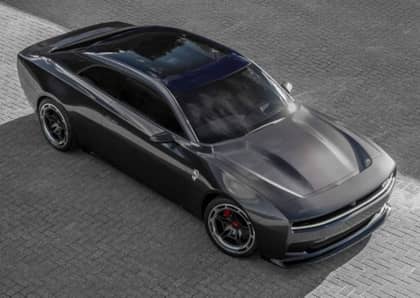The Best Dodge Charger Generations, Ranked From First To Worst
The Dodge Charger is one of the undisputed legends of the muscle car pantheon, and well-preserved examples continue to dazzle classic car fans 50 years past its first appearance on the scene. That being said, not every iteration of the Dodge Charger came with a fire-breathing Hemi engine, nor did all models deserve the same kind of breathless adoration heaped upon the vehicle's glory years. There have been ups and downs in the Charger's many decades of production, including several twists and turns that have seen the vehicle trade performance for frugality, and style for practicality.
Which versions of the Dodge Charger are our favorites? Here's our ranking of each and every Charger generation from first to worst.
1. 1968-1970 Dodge Charger
The '68-'70 Dodge Charger needs almost no introduction. This is the sleek, malevolent R/T coupe that hunted down Steve McQueen on the streets of San Francisco, the torque-monster dragster that defined Dom Toretto's character in the Fast and Furious franchise, and the vampire-hunting machine piloted by the daywalker, Blade, in his eponymous movie series—to say nothing of a certain starring role alongside Bo and Luke Duke.

That's just its Hollywood pedigree. On the street the Charger was a force to be reckoned with, available with 318, 383, 440, and of course 426 cubic inches of V8 fury, with underrated Hemi output maxing out at an 'official' 426hp.

It would also enjoy significant NASCAR success in the form of the Charger Daytona, which added a towering rear wing and an extended nose-cone to deliver some of the first true aerodynamic dominance in that racing series.

The B-body's hidden headlights and large, comfortable interior combined with its stunning performance and aggressive styling to make it one of the most popular muscle cars of all time, whether you are a Mopar fan or not.
2. 2011-2020 Dodge Charger
Some might balk at putting a four-door sedan at number two on our list ranking the best Dodge Charger generations, but hear us out.

This is the car that introduced the completely bonkers Hellcat drivetrain to the Charger world, bringing with it 707hp and 650 lb-ft of torque from a supercharged 6.2-liter V8. It would later provide the same drivetrain inside a wide-body package intended to stuff as much rubber under the Charger's fenders as possible for the ultimate in track stickiness.

The Hellcat alone would likely be enough to elevate the LD evolution of the LX platform to our number two spot, but it's just the tip of the iceberg when it comes to what the most recent Charger brings to the table. Two additional V8 engines—a 6.4L good for up to 485hp, and a 5.7L churning out 370 horses—throw down as mightily as the original coupe's drivetrain line-up ever did.

Toss in the availability of all-wheel drive, and a host of gnarly suspension upgrades available via a long list of options packages and trim levels, and you've got the last traditional American rear-wheel drive sedan on the market making Detroit proud.
3. 1966-1967 Dodge Charger
The original Charger was ignored for many years by muscle car fans focused exclusively on second generation models. Recent history has seen a course correction from collectors who now appreciate the sleek lines of the mid-'60s coupe and have elevated it into respectability both at auctions and classic car shows across the country.

The first-generation Dodge Charger presented an intriguing variant on the popular Coronet, with its fastback design and hidden headlights giving it a classy take on the era's sporty design themes. Features such as folding rear seats gave the car significant cargo space and added practicality to the two-door car, and it also saw its share of success on the NASCAR oval.

Dodge didn't push the Charger as a muscle car, but it could be ordered with nearly the same line-up of V8 engines as its more famous successor (including a 426 Hemi). Ultimately, debuting so close to the Ford Mustang and the Chevrolet Camaro (which provided much more focused performance), had an impact on the car's more restrained street reputation. This was a big part of what convinced Dodge to give the second-generation Charger its harder edge.
4. 1971-1974 Dodge Charger
The transition from the go-go 60s to the emissions-choked, insurance-hobbled '70s was difficult at best for the muscle car industry, but the Dodge Charger handled it better than most. The revised B-body was still a looker, and while it might have borrowed some of its styling cues from Pontiac's GTO Judge it remained poster-worthy for teens dreaming of a V8-powered tire shredder.

Early on the Hemi was still on the order sheet, but by 1972 it was gone. The Charger introduced a mid-range 400 cubic inch engine to replace the 383, with the 318, 340, and 440 soldiering on towards a gradually de-tuned future (a new 360 cubic inch motor would also become available).

Fewer and fewer Chargers were showing up at the drag strip, as the buyer shifted towards the grand touring, semi-luxury crowd similar that which was snapping up Chevrolet Monte Carlos and Ford Thunderbirds of the same era.
6. 2006-2010 Dodge Charger
When the Charger returned as a four-door sedan for the 2006 model year, it ruffled more than a few feathers. Despite being absent from the market for nearly 20 years, nostalgia would both help and hinder Dodge's latest iteration of the car.

Produced on the same platform as the Chrysler 300, and enjoying access to certain aspects of the Mercedes-Benz parts bin (thanks to corporate parent Daimler), the Charger was the most sophisticated model to bear the name.

The rear-wheel/all-wheel drive machine reintroduced not one, but two Hemi engines, along with the Daytona, SRT-8, and Super Bee trim levels, and it offered plenty of horsepower to ease the conscience of those scandalized by the idea of the Charger badge being paired with an extra set of doors.
7. 1983-1987 Dodge Charger
The 1980s saw Dodge less concerned with heritage than it was with keeping the corporate coffers full enough to avoid bankruptcy. As a result, an onslaught of small, affordable cars poured out of its factories, many of which were produced in partnership with import automakers willing to license their fuel efficient engine technologies.

The Dodge Charger would start out as a modest, Volkswagen-powered options package on the front-wheel Omni, and by 1983 it would graduate to its own model, this time with Peugeot power under the hood. Eventually, a Shelby version of the car featuring a 2.2-liter turbocharged four-cylinder would echo part of the Charger's high performance past, culminating in a 146hp effort by 1985.

A couple of years later the Charger would fade from showrooms, but not before a thousand examples were purchased by Shelby to be sold directly by his factory as the 'Shelby GLH-S.'
8. 1975-1978 Dodge Charger
There's a weird uncle in every family, and for the Dodge Charger it's the '75-'78 B-body.

By now fully embracing its pseudo-luxury status, the mid-'70s Charger would bloat up in terms of both length and width, and was motivated by an anemic trio of emissions-choked V8 engines that could barely crest the 225 horsepower mark.

Few cars survived the decade with their dignity intact, and today the Charger is seldom remember alongside other, similar coupes from the era like the Chrysler Cordoba and the Plymouth Fury.
More From Driving Line
- Curious about how today's Charger came to be? Check out this look at the Dodge concept that predicted the four-door version of the muscle car.











